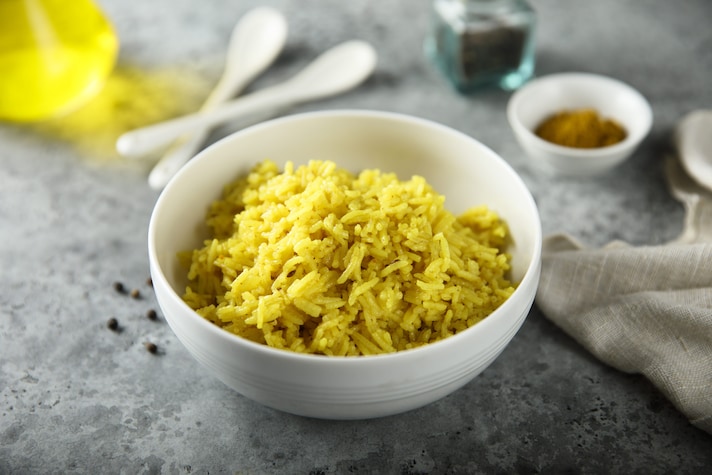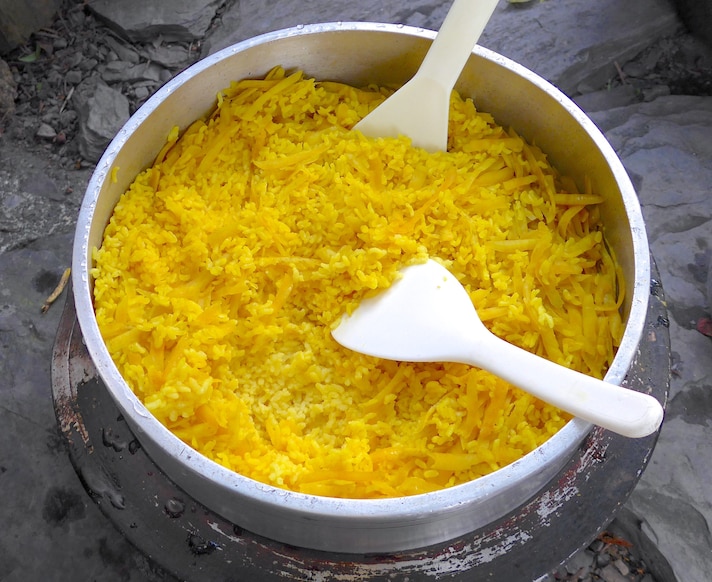
Ingredients
This turmeric rice with its warm and spicy notes brings all the comfort we need. Directly inspired by Indian cuisine, this is a colorful dish that has an addictive twist. Turmeric gives it its yellow color, and raisins and mint leaves add a touch of sweetness and freshness. The result for this vegan recipe is amazing, slightly spicy and will set all your senses on edge. Serve this turmeric flavored rice as a simple side dish or use it as a base for vegetarian single dishes or salads.
What is Turmeric?
Turmeric is a tuber similar to ginger. The use of turmeric gives the rice a yellow color and brings nutritional benefits. Used for centuries in Indian and Chinese culture, turmeric is usually used in curry recipes even if it's not spicy. It is also appreciated for its anti-inflammatory and anti-oxidant properties.
Turmeric Rice Ingredients

– Basmati rice. It is important to use long rice, whether it is basmati or jasmine rice.
– Fresh ginger. We recommend using fresh ginger rather than powdered in order to bring out more refreshing and fragrant notes.
– Turmeric powder. On the other hand, using turmeric powder rather than fresh turmeric is not a problem, the idea being to subtly spice up the rice. However, it is possible to replace it with grated fresh turmeric (about 2 tsp).
– Garlic. We use 2 cloves of garlic, but depending on their size or your sensitivity to garlic, you can use only one clove or add one or two.
– Olive oil. It can be replaced by coconut oil or for a non-vegan version by butter.
– Raisins. Another option is to replace them with dried cranberries or add dried apricots cut into tiny pieces.
– Fresh mint. The freshness of mint contrasts with the warm spices. If you don't have mint, freshly chopped coriander is a great addition to this dish.
– Pine nuts. They add a touch of crunch to the dish. Don't forget to toast them before adding them.
How to make Turmeric Rice

In just 20 minutes and minimal effort, you get a lovely turmeric rice dish. Start by frying the garlic, ginger and turmeric in a little olive oil, stirring often to prevent the mixture from sticking to the bottom. Do not forget to add salt. Add a volume of rice and 1.5 times its volume in water (not more). Bring the mixture to a boil, then lower the heat, cover and simmer for 15 minutes. All the water must be absorbed.
A few minutes before the end of the rice cooking, add the raisins to rehydrate them. Remove from heat and leave covered for 5 minutes. Stir quickly with a fork, adjust the seasoning, and it's ready! Just before serving, you can drizzle lemon juice over the rice. Sprinkle with toasted pine nuts, a few fresh mint leaves (chopped or not) and enjoy!
Tips
– Fresh or powdered ginger and turmeric? We recommend the use of fresh ginger, which brings aromatic notes to the whole. As for turmeric, you can either use the whole root and grate it like ginger or use turmeric powder to go faster.
– Remember to rinse the rice beforehand to remove excess starch.
– Let the rice rest after cooking in order to help the moisture spread properly in the pan and be absorbed by each grain of rice.
– You can use the same recipe to make cauliflower rice.
– To enrich the flavor, you can add your favorite vegetables or even chicken.
What to serve with Turmeric Rice
This turmeric basmati rice recipe will make an exceptional side dish and can also be used as a base for many vegetarian dishes. For example, you can serve it with chicken curry or coconut chickpea curry, add it to salads to make them more nutritious, or build a complete hot dish with roasted vegetables. Serve it with cauliflower steaks or sauteed Brussels sprouts. Use turmeric basmati rice to stuff peppers or squash.
How to store Turmeric Rice
You can store Turmeric Rice in the refrigerator in an airtight container for up to 2 days.
Can you freeze Turmeric Rice?
Yes! Freeze turmeric rice for up to 3 months. Before serving, thaw it an reheat it in a pan.
Instructions
Heat a little oil in a saucepan and sauté the minced garlic for a few seconds. Add the grated ginger, turmeric, salt and mix.
Add the basmati rice, cover with the indicated amount of water and bring to a boil. Reduce heat to low, cover with a lid and simmer for 15 minutes or until all water is absorbed. A few minutes before the end of cooking time, stir in the raisins to rehydrate.
Remove the pan from the heat and let stand for 5 minutes with the lid on. Stir gently with a fork to ensure that the grains are well separated from each other and season to taste. Finish by adding a splash of lemon juice if you want, then stir in the mint leaves and sprinkle with toasted pine nuts. Serve and enjoy!
Notes
To toast pine nuts, simply pour the pine nuts into a pan placed over medium-high heat without adding any fat, shaking the pan regularly to ensure that the pine nuts do not burn and are golden brown on all sides. It only takes a few seconds to toast pine nuts.
;Resize,width=767;)
